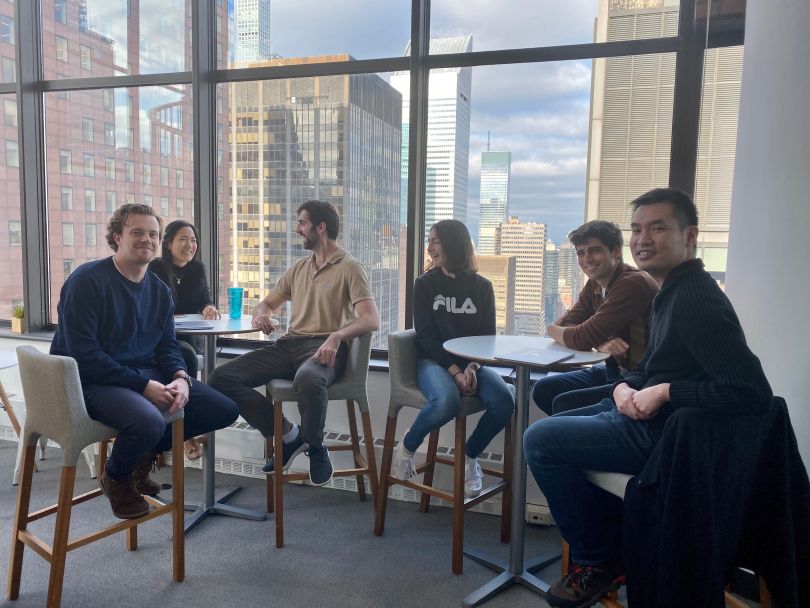When tech companies grow, design directors must find new ways to spark inspiration for their team so creative isn’t sacrificed when the workload stacks up.
Or as Lindsay Norman, director of design at Hinge said, “As our design team scales, we're constantly rethinking our processes to ensure that we have enough structure to work efficiently, but not so much so that we lose our creative spirit.” We asked two design directors at growing NYC tech companies how their teams stay in alignment while delivering the best products possible.
A couple tips we heard again and again? Hold weekly sketching sessions and make sure to get your team outside of the office.

Rather than helping users find quick flings, Hinge wants its users to find a relationship (and delete the app).
How do you inspire designers to make finding love user-friendly? Lindsay Norman, director of design, broke down how working with people outside the design team brings fresh insights to projects.
What processes, tools, methodologies, etc. were crucial in helping you scale your UX design process?
As our design team scales, we're constantly rethinking our processes to ensure that we have enough structure to work efficiently, but not so much so that we lose our creative spirit. We'll try something new for a few weeks and then evaluate whether or not it's something we want to adopt more permanently. Being flexible and open-minded to changes in the way we work has made scaling the team more fun.
One recent change we've made to our process is the addition of more formal design crits, kick-off meetings and handoffs. When you're a small team of just a few designers sitting next to each other, feedback is easy and things are more fluid. But as we've scaled, we've realized that critique is higher quality when we take the time to get in a room together, invite our periodic maintenance engineering partners and spend a dedicated amount of time each week to review the work.
Another improvement to our process has been working more collaboratively as a design team. We have started doing weekly sketching sessions to help unblock each other when we get stuck on our individual projects. As a design team grows, it makes sense to use the broader team to generate a lot of rough ideas early on in the design process. This also takes the pressure off any individual designer to come up with all the good ideas for his or her project.
Finally, we've moved our specs, project timelines and other design docs to Dropbox Paper. Standardizing the way we think through user problems has allowed us to work more efficiently and to be better aligned with our cross-functional partners.
We have started doing weekly sketching sessions to help unblock each other when we get stuck on our individual projects.”
As you scaled your UX design processes, how did you ensure team members still had the freedom to be creative and try new things?
For me, creative freedom in design is more of an attitude than a specific process or any one thing we've introduced in our workflow. It's allowing ideas to simmer rather than giving a concrete “yes” or “no” when they pop up. It's having the awareness when a designer is super jazzed about an idea and encouraging them to bring it to life, even if it's unlikely it'll make it on the roadmap.
As a design leader, you have to set the tone. When I lead a brainstorm, I like to be extra playful and goofy to inspire crazy, out-of-the-box thinking. When sketching, I like to draw something super obvious and dumb to demonstrate that we don't need to sketch like Picasso to come up with great solutions. In my experience, the more playful the vibe, the better the ideas.

Using big data, machine learning and AI, Reonomy helps real estate businesses compile and analyze property data to source building data, discover new investment opportunities and more. Director of UX Han Byul Ru said building a culture that celebrates wins creates a team ready to tackle more ambitious projects.
What processes, tools, methodologies, etc. were crucial in helping you scale your UX design process?
Scaling is top of mind for Reonomy as we just received $60 million in Series D funding. It's important for us to retain a product-driven culture as we continue to expand nationally and internationally throughout 2020.
Set your organization up for success by implementing a partnership model at the ground level. Staff each product area with product, tech and design leads and instill a sense of shared identity between those cross-functional team members.
Build a culture of celebrating users and design. Don't skip on weekly UX team syncs, get out of the office regularly to do fun things, share research findings and designs at company huddles and set UX-internal goals.
Empower, don't police on following a process. As your company scales, this statement will increasingly ring true: there is no one-size-fits-all process. Give clear guidance on which tools and methods are best for when, and give your team the space to train and exercise their own discernment.
Build a culture of celebrating users and design.”
As you scaled your UX design processes, how did you ensure team members still had the freedom to be creative and try new things?
Give clear boundaries for ownership and encourage designers to set ambitious KPIs for their domain. Equip them to make results-driven and data-driven design decisions with their counterparts in product and engineering. That will involve doing some homework before having those discussions. Conduct competitive analyses, run user tests and identify patterns in usage metrics and agree on what challenges are worth tackling.






